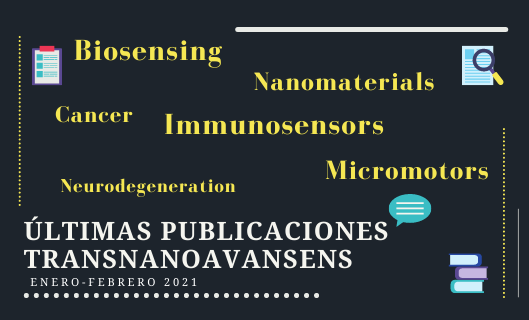Durante los meses de enero y febrero de 2021 se han publicado 10 artículos científicos de los grupos de investigación del programa Transnanoavansens, de ellos 3 Reviews y 1 Open access.
V. Serafín, C.A. Razzino, M. Gamella, M. Pedrero, E. Povedano, A. Montero-Calle, R. Barderas, M. Calero, A.O. Lobo, P. Yáñez-Sedeño, S. Campuzano, J.M. Pingarrón. Analytical & Bioanalytical Chemistry 413 (2021) 799-811.
Early diagnosis in primary care settings can increase access to therapies and their efficiency as well as reduce health care costs. In this context, we report in this paper the development of a disposable immunoplatform for the rapid and simultaneous determination of two protein biomarkers recently reported to be involved in the pathological process of neurodegenerative disorders (NDD), tau protein (tau), and TAR DNA-binding protein 43 (TDP-43).
Dual immunosensing platform, Tau, TDP-43, Amperometric detection, Plasma, Brain tissue extracts
Dual‐Propelled Lanbiotic Based Janus Micromotors for Selective Inactivation of Bacterial Biofilms.
K. Yuan, B. Jurado‐Sánchez, A. Escarpa. Angewandte Chemie International Edition, 60, 9 (2021) 4915-4924.
Specific interaction of Nisin with the Lipid II unit of Staphylococcus Aureus bacteria in connection with the enhanced micromotor movement and generated fluid flow result in a 2‐fold increase of the capture/killing ability (both in bubble and magnetic propulsion modes) as compared with free peptide and static counterparts. The high stability of Nisin along with the high towing force of the micromotors allow for efficient operation in untreated raw media (tap water, juice and serum) and even in blood and in flowing blood in magnetic mode.
Self‐propelled micromotors, Lanbiotics, Nisin molecule, Staphylococcus aureus, Janus micromotors
Electrocatalytic (bio)platforms for the determination of tetracyclines (Review Paper)
P. Yáñez-Sedeño, M. Pedrero, S. Campuzano, J.M. Pingarrón. Journal of Solid State Electrochemistry, 25 (2021) 3-13.
This article reviews in a general but comprehensive way recent contributions of electrochemical (bio)sensors developed for the determination of TCs and applied to TC analysis in environmental samples, food, and biological matrices. The highlighted representative methods show the key role played both by the materials (mostly nanomaterials and polymers) employed to impart surface electrocatalytic properties and significant signal amplification, and by different (bio)receptors to provide electrochemical sensing with the sensitivity and selectivity demanded by the determination of TCs in environmental, clinical, and food samples.
Electrochemical sensors, Electrochemical sensing, Antibiotics
B. Arévalo, A. ben Hassine, A. Valverde, V. Serafín, A. Montero-Calle, N. Raouafi, J. Camps, M. Arenas, R. Barderas, P. Yáñez-Sedeño, S. Campuzano, J.M. Pingarrón. Talanta, 225 (2021) 122054.
This work reports a magnetic microbeads (MBs)-based sandwich immunoassay for the amperometric determination of MMP-9 at screen-printed carbon electrodes (SPCEs). The suitable capture antibody (cAb) is immobilized onto carboxylic MBs to selectively capture the antigen which is sandwiched with a biotinylated detector antibody (biotin-dAb) further conjugated with a commercial streptavidin-horseradish peroxidase (Strep-HRP) polymer.
Electrochemical immunosensor, MMP-9, Cell lysates, Serum, Breast cancer, TNBC
A. Valverde, A. Montero-Calle, R. Barderas, M. Calero, P. Yáñez-Sedeño, S. Campuzano, J.M. Pingarrón. Electrochimica Acta, 371 (2021) 137815.
This work reports the first magnetic microbeads (MBs)-based electrochemical bioplatform developed so far for the determination of NfL. The developed platform relies in a sandwich type immunoassay involving an HRP-secondary antibody to enzymatically label the detector antibody on the surface of commercial MBs functionalized with carboxylic acids.
Electrochemical immunoplatform, Neurofilament light protein, Neurodegeneration, Alzheimer's disease, Plasma, Brain tissues
J. F. Hernández-Rodríguez, D. Rojas, A. Escarpa. Chemistry, 93, 1 (2021) 167-183.
In this review, it is discussed the most significant emerging advances in the field of electrochemical (bio)-sensing and technologies for healthcare applications over the past 2 years
Anatomy, Sensors, Peptides and proteins, Electrodes, Biotechnology
E. Povedano, M. Gamella, R. M. Torrente-Rodríguez, A. Montero-Calle, M. Pedrero, G. Solís-Fernández, F. Navarro-Villoslada, R. Barderas, S. Campuzano, J. M. Pingarrón. Biosensors and Bioelectronics, 171 (2021) 112708.
This work describes the preparation of an immunoplatform for the sensitive and selective determination of N6-methyladenosine (m6A). The simple and fast protocol involves for the first time the use of micromagnetic immunoconjugates to establish a direct competitive assay between the m6A target and a biotinylated RNA oligomer bearing a single m6A enzymatically labelled with a commercial conjugate of streptavidin-peroxidase (Strep-HRP) as tracer.
m6A, Amperometry, Immunosensor, Metastatic cancer cells, Magnetic microbeads, Disposable electrodes
MoS2 quantum dots for on-line fluorescence determination of the food additive allura red.
A. Coloma, M. del Pozo, R. Martínez-Moro, E. Blanco, P. Atienzar, L. Sánchez, M.D. Petit-Domínguez, E. Casero, C. Quintana. Food Chemistry, 345 (2021) 128628.
This work presents an on-line fluorescence method for the allura red (AR) determination. The method is based on the fluorescence quenching of dots of MoS2 because of their interaction with the non-fluorescence dye. MoS2-dots were synthetized and characterized by spectroscopic techniques and High Resolution Transmission Electronic Microscopy (HR-TEM).
Molybdenum disulfide, Dots, Fluorescence inhibition, Allura red, Food additive, Flow injection analysis
S. Campuzano, P. Yáñez-Sedeño, J.M. Pingarrón. Sensors, 21, 1 (2021) 189, 1-31.
This review article puts forward electrochemical biosensing methods reported in the last five years for the determination of cytokines, summarizes recent developments and trends through a comprehensive discussion of selected strategies, and highlights the challenges to solve in this field. Considering the key role demonstrated in the last years by different materials (with nano or micrometric size and with or without magnetic properties), in the design of analytical performance-enhanced electrochemical biosensing strategies, special attention is paid to the methods exploiting these approaches.
Inflammatory cytokines, Electrochemical biosensing, Nanomaterials, Magnetic particles, Diazonium salt chemistry, Antibiofouling
Sensitive glyphosate electrochemiluminescence immunosensor based on electrografted carbon nanodots.
T. Guerrero-Esteban, C. Gutiérrez-Sánchez, E. Martínez-Periñán, M. Revenga-Parra, F. Pariente, E. Lorenzo. Sensors and Actuators B: Chemical, 330 (2021) 129389.
A novel electrochemiluminescence (ECL) immunosensor based on electrografted carbon nanodots (CND) is developed for the sensitive determination of glyphosate in soy milk and tea.
Immunosensor, Glyphosate, Carbon nanodots, Electrografting, Electrochemiluminescence

